
Wine Culture and Information since 2002 - Volume 22
 Wine Culture and Information since 2002 - Volume 22 |
|
Contrasts of Colli Bolognesi Superiore Classico Pignoletto and Vesuvio Lacryma Christi BiancoLacryma Christi BiancoPignoletto and Coda di Volpe grapes compared in the glasses of this month's tasting, distant interpretations of Emilia-Romagna and Campania |
|
Emilia-Romagna and Campania, from a wine making point of view, do not have much in common. Very different grapes are grown in their respective vineyards, the wines are – so to speak – the fruit of two different and distinct wine making cultures. The climatic and meteorological conditions occurring over the seasons obviously differ substantially. These conditions are not only determined by the geographical position, but also – and above all – by the morphology of the respective territories and by the orography of these lands. In the two regions, as in every other wine-growing area in the world, the enological styles and ways of making wine have lived through different histories and traditions, also conditioned – not least – by the grape varieties which, over the centuries, have settled and adapted in their respective lands. If on the one hand – for example – in Emilia-Romagna, especially in the western part, the wine culture is still expressed with sparkling wines, this style is, in general terms, rather unusual for the enological history of Campania. This month's tasting by contrast compares two white wines produced in Emilia-Romagna and Campania, different in composition and, of course, in character. The wine produced in Emilia-Romagna, in fact, is Colli Bolognesi Superiore Classico Pignoletto, produced with the homonymous grape, while the wine from Campania – Vesuvio Lacryma Christi Bianco – is generally produced with Coda di Volpe, despite its disciplinary provides for the use of as many as four different grapes. In both cases they are native varieties or in any case present in their respective territories for a long time. Obviously, Pignoletto and Coda di Volpe have nothing in common, therefore they make – by themselves – interesting elements for a tasting by contrast. Furthermore, the comparison becomes even more interesting because of the differences of the soils that characterize the two territories: hilly for Colli Bolognesi Superiore Classico Pignoletto, basically volcanic for Vesuvio Lacryma Christi Bianco.
|
|
Pignoletto grape is certainly the white grape variety which, more than any other, represents the enological production of the white wines of the Colli Bolognesi area. For a long time the origin of this variety has been debated, including the etymology of its name, also by supporting hypotheses and theories that – today – thanks to the help of research and science, have allowed us to definitively clarify the origins of this white grape variety. In the past, in fact, it was believed Pignoletto was similar to Pinot Blanc or even to Riesling Italico (name with which in Italy is called Welschriesling grape), however – thanks to comparison and genetic investigation – today we know this variety is actually genetically analogous to Grechetto di Todi, also known as Grechetto Gentile or Grechetto G5 clone. In other words, it is exactly the most famous native white grape of Umbria and that, in any case, it is not clear how it arrived in the lands of Emilia-Romagna. However, it should be noted that in this region Pignoletto started to be first mentioned and spread in the course of the 1800s, with reference to the north-western area near Bologna. In any case, it is a variety introduced in recent times in these lands and, very likely, it has come here from the “relatively” nearby Umbria, its land of origin. In Emilia-Romagna, however, Grechetto Gentile enjoys considerable spreading and is commonly found throughout the region, especially in the hills of Bologna and Imola. In this regard, it should be noted in the territory of Colli Bolognesi, Pignoletto is recognized as Controlled and Guaranteed Designation of Origin wine (Denominazione d'Origine Controllata e Garantita, DOCG) therefore belonging to the highest level of the Italian wine quality system. The production disciplinary provides for frizzante (slightly sparkling), spumante (sparkling), superiore and classico superiore styles, for which is required a minimum quantity of 85% of Pignoletto, with the exception of the classico superiore style, for which the minimum amount must be 95%. As for the aging, it is also allowed the use of the wooden cask.
|
||||
|
Lacryma Christi – literally, Christ's tears – is certainly the most famous and well-known wine of Vesuvio appellation, the renowned Vesuvius volcano of Campania and which surrounding area is recognized as a Denomination of Controlled Origin (Denominazione d'Origine Controllata, DOC). The origin of the name is clearly attributable to popular legends of a Christian religious nature and, in this regard, it should be noted the quality of the wines of these lands was already well-known and appreciated at the time of the ancient Romans. From a regulatory point of view, Lacryma Christi is a special mention of the Vesuvio DOC denomination and is produced in the styles white, rosé, red, sparkling white and fortified white. The production of the white styles involves the use of Coda di Volpe (literally “fox tail”, for a minimum of 35%), Verdeca (45% maximum), Falanghina and Greco (20% maximum) grapes. In this regard, it should be noted that, in most cases, the production of this style of wine is based on the exclusive use of Coda di Volpe variety. The allowed varieties for the production of the rosé and red styles are Piedirosso (minimum 50%), Sciascinoso (maximum 30%) and possibly Aglianico (maximum 20%). It should also be noted that for wines called “Lacryma Christi” the maximum yield of grapes into wine must not exceed 65%. Coda di Volpe – the main grape of Vesuvio Lacryma Christi Bianco – is a native variety of Campania and is found throughout the entire region. Grape of ancient origins, it was already known at the time of the ancient Romans, appreciated for the quality of its wines. The name derives from the shape of the bunches which, in the lower apical part, tend to “curve” to one side, so to recall the tail of a fox. Variety not easy to grow and from which make wine – it is not very vigorous and gives modest yields, when it reaches full ripeness it is characterized by a high quantity of sugar and a low total acidity – it requires wine making criteria of remarkable quality. Despite these characteristics, many producers in Campania, including those of the Vesuvio area, have been able to prove the interesting potentials of this grape also vinified alone, a custom that – traditionally speaking – was considered unsuitable for Coda di Volpe.
|
Let's proceed with the choice of the two bottles that we will pour into our glasses and compare them in this month's tasting by contrast. We will make sure – for both wines – that they belong to the most recent vintage and are produced using inert containers, preferably the steel tank. This wine making characteristic will allow the appreciation of the specific qualities of the wine, in particular the expression of the grapes in relation to the territory and, of course, the result of the secondary organoleptic sensations, that is, those deriving from alcoholic fermentation. As for Colli Bolognesi Classico Superiore Pignoletto – despite the production disciplinary provides for the minimum use of 95% of the homonymous grape – we will make sure that it is produced with 100% Pignoletto. We will do the same for Vesuvio Lacryma Christi Bianco, therefore we will make sure the wine is exclusively produced with Coda di Volpe grape. The two wines are poured into tasting glasses at a temperature of 10 °C (50 °F). Let's pour the two wines of this month's tasting by contrast into their respective glasses and begin the sensorial evaluation, examining their appearance, specifically, color and transparency. The first wine we examine is Colli Bolognesi Classico Superiore Pignoletto. By tilting the glass over a white surface – a sheet of paper is enough – and by observing the base, let's assess the color. Pignoletto has a bright straw yellow color and high transparency. The nuance, observed near the opening of the glass, reveals a straw yellow color tending to greenish. Let's now pass to the evaluation of Vesuvio Lacryma Christi Bianco and, as for the previous wine, let's tilt the glass over the white surface. The color of the wine from Campania – observed at the base of the glass – reveals an intense straw yellow hue and high transparency. The nuance, observed at the edge of the glass, towards the opening, reveals a greenish yellow color. The aromas expressed by wines produced with Pignoletto and Coda di Volpe grapes are quite different and – in this sense – Colli Bolognesi Classico Superiore Pignoletto and Vesuvio Lacryma Christi Bianco are no exception when compared one to each other. Pignoletto, which should be noted is the name with which Grechetto Gentile is traditionally called in Emilia-Romagna, is recognized for the pleasing aromas of fruits and flowers, in particular apple, pear and plum, as well as hawthorn and broom. Just like the wines produced with this grape in Umbria, the homeland of Grechetto Gentile, a pleasing hint of hazelnut and almond is often perceived. Coda di Volpe, in particular in the expression of Vesuvio Lacryma Christi Bianco, is characterized by aromas directly recalling apple, pear and peach, frequently followed by sensations reminiscent of exotic fruit, in particular pineapple. Of course, Coda di Volpe wines also express olfactory qualities reminiscent of flowers, in particular hawthorn and broom, sometimes followed by acacia. Let's resume the sensorial analysis of the wines of our tasting by contrast, by examining the respective olfactory profiles. Just like the previous phase, let's start from Colli Bolognesi Classico Superiore Pignoletto. By holding the glass of this wine in vertical position and, without swirling, let's proceed with the first smell in order to appreciate its opening aromas, that is the identifying ones. On the nose we appreciate aromas of apple, pear, plum as well as the floral sensation in which can be recognized hawthorn. After having swirled the glass, let's do the second smell which will complete the olfactory profile of Colli Bolognesi Classico Superiore Pignoletto with broom, peach and pineapple as well as sensations reminiscent of citrus fruits, hazelnut and almond. Let's now pass to the evaluation of Vesuvio Lacryma Christi Bianco, in particular, to the opening aromas. From the glass emerge aromas of apple, pear and peach and a floral note in which can be recognized broom. After having swirled the glass, the olfactory profile of the wine from Campania is completed with plum, pineapple, hawthorn, acacia, almond and, frequently, a pleasing hint of anise. Let's now proceed with the evaluation of the gustatory profiles of the wines of our tasting by contrast, starting – like in the previous phases – from Colli Bolognesi Classico Superiore Pignoletto. Let's take a sip of this wine and evaluate the attack, that is its primary and identifying gustatory sensations. In the mouth can be immediately perceived the crispness given by the acidity as well as a sensation of good structure. The wine finds its balance thanks to the effects of alcohol as well as the moderate sensation of roundness. In the mouth are perceived, confirming a good correspondence to the nose, the flavors of apple, pear and plum. Let's now move on to the gustatory evaluation of Vesuvio Lacryma Christi Bianco and take a sip of this wine in order to appreciate its attack. In the mouth we immediately perceive a good acidity that finds balance both with the action of alcohol and roundness, generally more intense than the previous wine. The structure of this wine is very good and in the mouth are perceived the flavors of pear, apple, peach and pineapple. We have reached the final phase of the tasting by contrast of this month, therefore let's evaluate the final sensations the wines leave in the mouth, in particular the taste-olfactory persistence, primary factor in the quality of every wine. After having swallowed the sample of Colli Bolognesi Classico Superiore Pignoletto, in the mouth we can appreciate a good persistence in which we continue to perceive the sensation of crispness in addition to the flavors of apple, plum and hazelnut, as well as a pleasant bitter sensation in which we can recognize almond. The finish of Vesuvio Lacryma Christi Bianco is persistent and the pleasing crispness continues to be perceived in the mouth as well as a slightly more intense sensation of roundness than the wine from Emilia-Romagna. In the mouth are clearly perceived the flavors of pear, apple, peach and pineapple. Let's now place the two glasses next to each other and proceed with the last comparative smell: the aromas expressed by the two wines are still clearly different and distant.
|
||||||||
Wines of the Month |
|
|
|
Score legend Prices are to be considered as indicative. Prices may vary according to the country or the shop where wines are bought |

|
|
Conegliano Valdobbiadene Prosecco Superiore Extra Brut Rive di Ogliano 2019 |
|
| Biancavigna (Veneto, Italy) | |
 Glera Glera | |
| Price: € 12.00 | Score: |
 Brilliant greenish yellow and nuances of greenish yellow, very
transparent, fine and persistent perlage. Brilliant greenish yellow and nuances of greenish yellow, very
transparent, fine and persistent perlage.
 Intense, clean, pleasing, refined and elegant, starts with hints of
kiwi, pear and wisteria followed by aromas of hawthorn, broom, chamomile,
green apple, peach, tangerine, white melon, apricot and pineapple. Intense, clean, pleasing, refined and elegant, starts with hints of
kiwi, pear and wisteria followed by aromas of hawthorn, broom, chamomile,
green apple, peach, tangerine, white melon, apricot and pineapple.
 Effervescent and crisp attack, however balanced by alcohol, light body,
intense flavors, agreeable. Effervescent and crisp attack, however balanced by alcohol, light body,
intense flavors, agreeable.
 Persistent finish with flavors of kiwi, pear and green apple. Persistent finish with flavors of kiwi, pear and green apple. Refermented in closed tank for 5 months. Refermented in closed tank for 5 months. |
|
 Aperitifs, Fish and crustacean appetizers, Pasta and risotto with crustacean and vegetables, Dairy products, Sauteed fish Aperitifs, Fish and crustacean appetizers, Pasta and risotto with crustacean and vegetables, Dairy products, Sauteed fish |
|

|
|
Conegliano Valdobbiadene Prosecco Superiore Extra Brut Rive di Soligo 2019 |
|
| Biancavigna (Veneto, Italy) | |
 Glera (98%), Verdisio (1%), Perera (1%) Glera (98%), Verdisio (1%), Perera (1%) | |
| Price: € 15.00 | Score: |
 Brilliant greenish yellow and nuances of greenish yellow, very
transparent, fine and persistent perlage. Brilliant greenish yellow and nuances of greenish yellow, very
transparent, fine and persistent perlage.
 Intense, clean, pleasing, refined and elegant, starts with hints of
pear, green apple and wisteria followed by aromas of broom, hawthorn,
jasmine, tangerine, peach, plum, apricot, pineapple and citron. Intense, clean, pleasing, refined and elegant, starts with hints of
pear, green apple and wisteria followed by aromas of broom, hawthorn,
jasmine, tangerine, peach, plum, apricot, pineapple and citron.
 Effervescent and crisp attack, however balanced by alcohol, light body,
intense flavors, agreeable. Effervescent and crisp attack, however balanced by alcohol, light body,
intense flavors, agreeable.
 Persistent finish with flavors of green apple, pear and tangerine. Persistent finish with flavors of green apple, pear and tangerine. Refermented in closed tank for 5 months. Refermented in closed tank for 5 months. |
|
 Aperitifs, Fish and crustacean appetizers, Pasta and risotto with crustaceans and vegetables, Dairy products, Eggs, Sauteed fish Aperitifs, Fish and crustacean appetizers, Pasta and risotto with crustaceans and vegetables, Dairy products, Eggs, Sauteed fish |
|
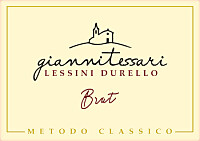
|
|
Lessini Durello Metodo Classico Brut |
|
| Gianni Tessari (Veneto, Italy) | |
 Durella Durella | |
| Price: € 19.00 | Score: |
 Intense straw yellow and nuances of straw yellow, very transparent,
fine and persistent perlage. Intense straw yellow and nuances of straw yellow, very transparent,
fine and persistent perlage.
 Intense, clean, pleasing, refined and elegant, starts with hints of
peach, grapefruit and bread crust followed by aromas of hawthorn, citron,
apple, jasmine, medlar, pear, plum, beeswax and hazelnut. Intense, clean, pleasing, refined and elegant, starts with hints of
peach, grapefruit and bread crust followed by aromas of hawthorn, citron,
apple, jasmine, medlar, pear, plum, beeswax and hazelnut.
 Effervescent and crisp attack, however balanced by alcohol, good body,
intense flavors, agreeable. Effervescent and crisp attack, however balanced by alcohol, good body,
intense flavors, agreeable.
 Persistent finish with flavors of apple, plum and grapefruit. Persistent finish with flavors of apple, plum and grapefruit. Refermented in bottle on its lees for at least 3 years. Refermented in bottle on its lees for at least 3 years. |
|
 Pasta with fish, Roasted fish, Roasted white meat, Legume soups, Broiled crustaceans Pasta with fish, Roasted fish, Roasted white meat, Legume soups, Broiled crustaceans |
|
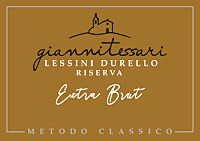
|
|
Lessini Durello Riserva Metodo Classico Extra Brut 2013 |
|
| Gianni Tessari (Veneto, Italy) | |
 Durella Durella | |
| Price: € 30.00 | Score: |
 Brilliant straw yellow and nuances of straw yellow, very transparent,
fine and persistent perlage. Brilliant straw yellow and nuances of straw yellow, very transparent,
fine and persistent perlage.
 Intense, clean, pleasing, refined and elegant, starts with hints of
apple, peach and bread crust followed by aromas of citron, hawthorn, broom,
honey, kiwi, pear, hazelnut, plum, grapefruit and praline. Intense, clean, pleasing, refined and elegant, starts with hints of
apple, peach and bread crust followed by aromas of citron, hawthorn, broom,
honey, kiwi, pear, hazelnut, plum, grapefruit and praline.
 Effervescent and crisp attack, however balanced by alcohol, good body,
intense flavors, agreeable. Effervescent and crisp attack, however balanced by alcohol, good body,
intense flavors, agreeable.
 Persistent finish with flavors of apple, citron and honey. Persistent finish with flavors of apple, citron and honey. Refermented in bottle on its lees for at least 5 years. Refermented in bottle on its lees for at least 5 years. |
|
 Pasta with fish and crustaceans, Stewed fish, Stewed crustaceans, Dairy products, Sauteed white meat Pasta with fish and crustaceans, Stewed fish, Stewed crustaceans, Dairy products, Sauteed white meat |
|
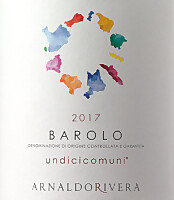
|
|
Barolo Undicicomuni 2017 |
|
| Arnaldo Rivera (Piedmont, Italy) | |
 Nebbiolo Nebbiolo | |
| Price: € 30.00 | Score: |
 Brilliant ruby red and nuances of garnet red, moderate transparency. Brilliant ruby red and nuances of garnet red, moderate transparency. Intense, clean, pleasing, refined and elegant, starts with hints of
cherry, raspberry and dried violet followed by aromas of dried rose, plum,
strawberry, chocolate, cinnamon, tobacco, licorice, anise, vanilla and
menthol. Intense, clean, pleasing, refined and elegant, starts with hints of
cherry, raspberry and dried violet followed by aromas of dried rose, plum,
strawberry, chocolate, cinnamon, tobacco, licorice, anise, vanilla and
menthol.
 Tannic attack and however balanced by alcohol, full body, intense
flavors, pleasing crispness. Tannic attack and however balanced by alcohol, full body, intense
flavors, pleasing crispness.
 Persistent finish with flavors of cherry, raspberry and plum. Persistent finish with flavors of cherry, raspberry and plum. 26 months in cask, 6 months in cement tanks. 26 months in cask, 6 months in cement tanks. |
|
 Game, Roasted meat, Stewed and braised meat with mushrooms, Hard cheese Game, Roasted meat, Stewed and braised meat with mushrooms, Hard cheese |
|
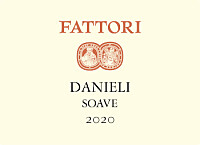
|
|
Soave Danieli 2020 |
|
| Fattori (Veneto, Italy) | |
 Garganega Garganega | |
| Price: € 6.80 | Score: |
 Pale straw yellow and nuances of greenish yellow, very transparent. Pale straw yellow and nuances of greenish yellow, very transparent. Intense, clean, pleasing and refined, starts with hints of apple, pear
and peach followed by aromas of hawthorn, nettle, broom, citrus fruits,
plum, pineapple and almond. Intense, clean, pleasing and refined, starts with hints of apple, pear
and peach followed by aromas of hawthorn, nettle, broom, citrus fruits,
plum, pineapple and almond.
 Crisp attack and however balanced by alcohol, good body, intense
flavors, agreeable. Crisp attack and however balanced by alcohol, good body, intense
flavors, agreeable.
 Persistent finish with flavors of apple, pear and peach. Persistent finish with flavors of apple, pear and peach. Aged in steel tanks. Aged in steel tanks. |
|
 Pasta and risotto with fish and crustaceans, Sauteed fish, Vegetable soups Pasta and risotto with fish and crustaceans, Sauteed fish, Vegetable soups |
|
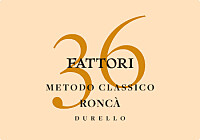
|
|
Lessini Durello Metodo Classico Brut Roncà 36 Mesi 2015 |
|
| Fattori (Veneto, Italy) | |
 Durella Durella | |
| Price: € 14.80 | Score: |
 Brilliant greenish yellow and nuances of greenish yellow, very
transparent, fine and persistent perlage. Brilliant greenish yellow and nuances of greenish yellow, very
transparent, fine and persistent perlage.
 Intense, clean, pleasing and refined, starts with hints of apple, plum
and bread crust followed by aromas of hawthorn, citron, broom, pear, kiwi,
grapefruit, hazelnut and mineral. Intense, clean, pleasing and refined, starts with hints of apple, plum
and bread crust followed by aromas of hawthorn, citron, broom, pear, kiwi,
grapefruit, hazelnut and mineral.
 Effervescent and crisp attack, however balanced by alcohol, good body,
intense flavors, agreeable. Effervescent and crisp attack, however balanced by alcohol, good body,
intense flavors, agreeable.
 Persistent finish with flavors of apple, plum and citron. Persistent finish with flavors of apple, plum and citron. The base wine ferments in steel tanks and cask, then referments in
bottle on its lees for 36 months. The base wine ferments in steel tanks and cask, then referments in
bottle on its lees for 36 months.
|
|
 Aperitifs, Fish and crustacean appetizers, Fried fish, Risotto with crustaceans, Dairy products Aperitifs, Fish and crustacean appetizers, Fried fish, Risotto with crustaceans, Dairy products |
|

|
|
Vermentino di Gallura Superiore Maia 2019 |
|
| Siddura (Sardinia, Italy) | |
 Vermentino Vermentino | |
| Price: € 21.00 | Score: |
 Brilliant straw yellow and nuances of straw yellow, very transparent. Brilliant straw yellow and nuances of straw yellow, very transparent. Intense, clean, pleasing and refined, starts with hints of apple, plum
and hawthorn followed by pear, broom, peach, citrus fruits, medlar,
pineapple and almond. Intense, clean, pleasing and refined, starts with hints of apple, plum
and hawthorn followed by pear, broom, peach, citrus fruits, medlar,
pineapple and almond.
 Crisp attack and however balanced by alcohol, good body, intense
flavors, pleasing roundness. Crisp attack and however balanced by alcohol, good body, intense
flavors, pleasing roundness.
 Persistent finish with flavors of apple, plum and almond. Persistent finish with flavors of apple, plum and almond. Aged in seel tanks. Aged in seel tanks. |
|
 Fried fish, Pasta with fish, Stewed fish, Sauteed white meat, Dairy products Fried fish, Pasta with fish, Stewed fish, Sauteed white meat, Dairy products |
|

|
|
Cannonau di Sardegna Riserva Fola 2018 |
|
| Siddura (Sardinia, Italy) | |
 Cannonau Cannonau | |
| Price: € 21.00 | Score: |
 Intense ruby red and nuances of garnet red, moderate transparency. Intense ruby red and nuances of garnet red, moderate transparency. Intense, clean, pleasing, refined and elegant, starts with hints of
plum, blueberry and black cherry followed by aromas of violet, blackberry,
raspberry, carob, chocolate, tobacco, mace, cinnamon and vanilla. Intense, clean, pleasing, refined and elegant, starts with hints of
plum, blueberry and black cherry followed by aromas of violet, blackberry,
raspberry, carob, chocolate, tobacco, mace, cinnamon and vanilla.
 Properly tannic attack and however balanced by alcohol, good body,
intense flavors, pleasing roundness. Properly tannic attack and however balanced by alcohol, good body,
intense flavors, pleasing roundness.
 Persistent finish with flavors of plum, blueberry and black cherry. Persistent finish with flavors of plum, blueberry and black cherry. Aged in cask. Aged in cask. |
|
 Stuffed pasta, Broiled meat and barbecue, Roasted meat, Stewed meat with mushrooms, Hard cheese Stuffed pasta, Broiled meat and barbecue, Roasted meat, Stewed meat with mushrooms, Hard cheese |
|
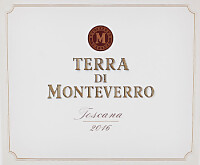
|
|
Terra di Monteverro 2016 |
|
| Monteverro (Tuscany, Italy) | |
 Cabernet Sauvignon (40%), Cabernet Franc (40%), Merlot (15%), Petit Verdot (5%) Cabernet Sauvignon (40%), Cabernet Franc (40%), Merlot (15%), Petit Verdot (5%) | |
| Price: € 39.00 | Score: |
 Deep ruby red and nuances of garnet red, little transparency. Deep ruby red and nuances of garnet red, little transparency. Intense, clean, pleasing, refined and elegant, starts with hints of
black currant, plum and dried violet followed by aromas of black cherry,
blueberry, iris, bell pepper, cocoa, tobacco, face powder, fern, licorice,
mace, vanilla and eucalyptus. Intense, clean, pleasing, refined and elegant, starts with hints of
black currant, plum and dried violet followed by aromas of black cherry,
blueberry, iris, bell pepper, cocoa, tobacco, face powder, fern, licorice,
mace, vanilla and eucalyptus.
 Properly tannic attack and however balanced by alcohol, full body,
intense flavors, pleasing roundness. Properly tannic attack and however balanced by alcohol, full body,
intense flavors, pleasing roundness.
 Persistent finish with flavors of black currant, plum and black cherry. Persistent finish with flavors of black currant, plum and black cherry. 20 months in barrique. 20 months in barrique. |
|
 Game, Roasted meat, Stewed and braised meat, Hard cheese Game, Roasted meat, Stewed and braised meat, Hard cheese |
|
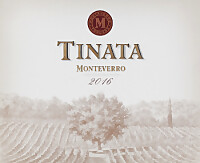
|
|
Tinata 2016 |
|
| Monteverro (Tuscany, Italy) | |
 Syrah (70%), Grenache Noir (30%) Syrah (70%), Grenache Noir (30%) | |
| Price: € 83.00 | Score: |
 Deep ruby red and nuances of ruby red, little transparency. Deep ruby red and nuances of ruby red, little transparency. Intense, clean, pleasing, refined and elegant, starts with hints of
black cherry, plum and black currant followed by aromas of dried violet,
carnation, blueberry, lavender, rosemary, chocolate, tobacco, black
pepper, mace, vanilla and eucalyptus. Intense, clean, pleasing, refined and elegant, starts with hints of
black cherry, plum and black currant followed by aromas of dried violet,
carnation, blueberry, lavender, rosemary, chocolate, tobacco, black
pepper, mace, vanilla and eucalyptus.
 Properly tannic attack and however balanced by alcohol, full body,
intense flavors, pleasing roundness. Properly tannic attack and however balanced by alcohol, full body,
intense flavors, pleasing roundness.
 Persistent finish with flavors of plum, black currant and black cherry. Persistent finish with flavors of plum, black currant and black cherry. 16 month in barrique and cement tanks. 16 month in barrique and cement tanks. |
|
 Game, Roasted meat, Stewed and braised meat, Cheese Game, Roasted meat, Stewed and braised meat, Cheese |
|
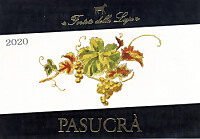
|
|
Piemonte Moscato Secco Pasucrà 2020 |
|
| Forteto della Luja (Piedmont, Italy) | |
 Moscato Bianco Moscato Bianco | |
| Price: € 9.80 | Score: |
 Brilliant golden yellow and nuances of golden yellow, very transparent. Brilliant golden yellow and nuances of golden yellow, very transparent. Intense, clean, pleasing and refined, starts with hints of grape, peach
and citrus fruits followed by aromas of white rose, lychee, banana, pear,
apple, broom and sage. Intense, clean, pleasing and refined, starts with hints of grape, peach
and citrus fruits followed by aromas of white rose, lychee, banana, pear,
apple, broom and sage.
 Crisp attack and however balanced by alcohol, good body, intense
flavors, agreeable. Crisp attack and however balanced by alcohol, good body, intense
flavors, agreeable.
 Persistent finish with flavors of grape, peach and lychee. Persistent finish with flavors of grape, peach and lychee. Aged in steel tanks. Aged in steel tanks. |
|
 Pasta and risotto with crustaceans and mushrooms, Broiled crustaceans, Sauteed white meat with mushrooms Pasta and risotto with crustaceans and mushrooms, Broiled crustaceans, Sauteed white meat with mushrooms |
|
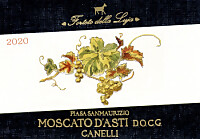
|
|
Moscato d'Asti Canelli Piasa San Maurizio 2020 |
|
| Forteto della Luja (Piedmont, Italy) | |
 Moscato Bianco Moscato Bianco | |
| Price: € 9.50 | Score: |
 Intense straw yellow and nuances of straw yellow, very transparent. Intense straw yellow and nuances of straw yellow, very transparent. Intense, clean, pleasing and refined, starts with hints of grape, peach
and apricot followed by aromas of citron, white rose, broom, lychee, apple,
pear, honey and sage. Intense, clean, pleasing and refined, starts with hints of grape, peach
and apricot followed by aromas of citron, white rose, broom, lychee, apple,
pear, honey and sage.
 Sweet and crisp attack, however balanced by alcohol, light body,
intense flavors, pleasing effervescence. Sweet and crisp attack, however balanced by alcohol, light body,
intense flavors, pleasing effervescence.
 Persistent finish with flavors of grape, peach and apricot. Persistent finish with flavors of grape, peach and apricot. Fermented in closed tank. Fermented in closed tank. |
|
 Cream desserts, Fruit desserts, Semifreddo Cream desserts, Fruit desserts, Semifreddo |
|
|
||||||||
|
DiWineTaste Polls
|
| |||||||
Privacy Policy | |||||||


| Copyright © 2002-2024 Antonello Biancalana, DiWineTaste - All rights reserved |
| All rights reserved under international copyright conventions. No part of this publication and of this WEB site may be
reproduced or utilized in any form or by any means, electronic or mechanical, without permission in writing from DiWineTaste. |